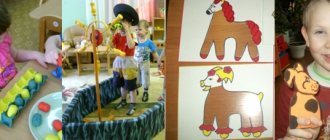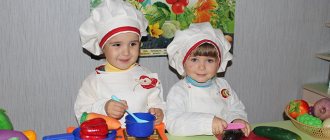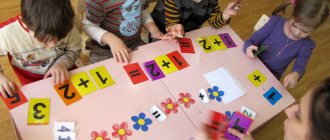Progress of the game
The teacher selects objects familiar to the children. Conducts a short conversation about what it is, what it is, what it is needed for.
Children take turns putting their hand into the bag, finding an object and calling it, then taking it out and showing it. You can put all the items in a bag, the children choose one and name it. You can put 1 item in the bag and leave the rest on the table. The children guess by touch what kind of object it is, the other children say whether they guessed correctly or not. If the child finds it difficult to answer, we ask riddles about the subject. Either the child describes the object, and the others guess it.
Card No. 20 D/game “Who will collect it sooner?”
(
pozn .) Program content: continue to teach children how to assemble a pyramid correctly, practice naming the size of the ring (large, smaller, smallest)
.
Game rules: string the rings after the teacher’s signal.
Progress of the game
A variety of toys are selected, among which there should be absolutely identical ones. During the game, remove or add toys. “Now we'll play. There are toys on the table. I will count to three, and at this time you must find two completely identical ones. Be careful! Whoever finds it raises his hand, comes up to me and speaks in a whisper. One two Three! Find the same ones!”
To complicate the game and increase attention, you can place toys that are almost identical, but different in color or size.
More often involve children who are absent-minded, inattentive, and who rush to answer without thinking.
Card No. 25 D/game “In the poultry yard”
(
pozn .) Program content: consolidate children’s knowledge of how poultry scream, develop correct sound pronunciation.
Game rules: everyone pronounces sounds loudly in chorus, imitating birds.
Progress of the game
There are 2 dolls sleeping on the beds: a large one and a small one. There are clothes on the shelves of the closet. Children sit on chairs in a semicircle. Teacher: “Children, look who sleeps in this crib. Did you recognize her? Yes, this is a Katya doll. Who sleeps on this one? This is a Tanya doll.” The teacher turns to one doll: “Katya, are you awake yet? Will you get up? Guys, she says she wants to get up, but first we need to find her clothes. What do you need to dress Katya?
“Look carefully at the shelf. Do you see the clothes? Bring a dress. We try on the dress, if it’s small, we fold it next to Tanya’s crib. Should we put on the dress right away or should we put on other things first? We are looking for underwear in size and other things for the dolls.” Children take turns putting clothes on the Katya doll, then dressing Tanya.
Card No. 15 D/game “Katya the doll is having lunch”
"
(
pozn .) Program content: consolidate children's knowledge about tableware, activate their speech, cultivate a culture of behavior while eating, teach them to treat a doll with care.
Game rules: correctly find and select dishes for dinner, correctly display objects. When choosing the right utensils, children clap their hands, and if they make a mistake, they shake their fingers.
Progress of the game
The teacher shows the children one by one 3-5 objects (different types, the same type, but different colors and sizes)
. Together with the children, he names objects, notes color and size.
Questions about objects of the same type: “Are they the same size or not? What's different about them? Look carefully!" Then the teacher asks the children to remember which objects stand and how. Covers the toys with a screen and rearranges objects, changes places, removes one or two toys. One child answers: who noticed first or who the teacher names.
Card No. 18 D/game “Such a leaf, fly to me!”
(
pozn .) Program content: exercise children in finding leaves by similarity, activate the vocabulary (maple, oak, rowan, birch, cultivate auditory attention.
Game rules: run after you correctly name the tree from which the leaf comes (after the teacher’s words “Such a leaf, fly to me!”
Progress of the game.
The game is played after the children have become acquainted with the work of a nanny , a cook, and have learned what kind of utensils are used in their work.
3 dolls: a cook stands at the stove, a nanny doll in a dressing gown prepares dishes for dinner, a girl doll sits at the table. The teacher looks at the dolls with the children, talks about what they do, what kind of utensils they need. There are different dishes on the table near the teacher. Showing the object, the teacher tells what it is called (asks about it)
.To maintain interest, you can ask like this:
“But this dishware is probably not needed by anyone.”
Both the cook and the nanny need a ladle, a teapot, and a spoon. Children themselves can play the role of a cook, a nanny, or a girl going to dinner.
Card No. 14 D/game “The dolls woke up”
"
(
pozn .) Program content: consolidate knowledge about the names of clothes, the sequence of dressing, activate children's speech.
Game rules: select the necessary clothes by size, name the clothes in the order of dressing.
Progress of the game
Play with a small group of children . The teacher, having seated the children at the table, distributes a pyramid to everyone. Looking at his pyramid, he draws the children’s attention to it: “Which ring is below: big or small? (big)
.
What's the ring above it? (slightly less)
. Remember, the largest ring is at the bottom. Which one is upstairs? Now let's play. First, let's look at the pyramids. And when I hit the ring on the table, you will quickly begin to assemble the pyramid. We need to assemble it correctly. Whoever collects the fastest will win and receive a prize.”
The teacher reminds that you need to look for the largest ring each time.
Card No. 21 D / game “Find an object by description”
(
pozn .) Program content: practice finding an object by its characteristic features, develop observation , resourcefulness, teach children to describe an object without naming it, cultivate self-control.
Game rules: the one who is named Pinocchio is looking for.
Progress of the game
The game uses natural materials, toys, pictures of the same type , but of different sizes, the same number of each group of objects.
The children sit at the table and the teacher looks at the objects together with them, the children name them. The teacher asks if the objects are the same size, asks to show the largest, smaller, smallest. “We will learn to arrange them by size: first we will put the largest object, then the smaller one, then the smallest one. Only identical items should be placed in one row. Begin!"
3-6 objects at a time, children exchange objects and arrange them again. Then they do the same thing, but in increasing quantities.
Card No. 17 D/game “What has changed?”
(
pozn .) Program content: to train children in the correct naming of objects and actions, to teach them to notice and name differences in color and clothing, to develop visual memory , voluntary memorization, observation and speech.
Game rules: the one whom the teacher calls answers.
Progress of the game
The teacher informs the children that the residents of the doll corner, Katya the doll and Misha the bear cub, are moving to a new apartment. A car has arrived at the new house and we need to unload our things. The bear makes mistakes all the time, doesn’t know where to put what. Children help the toys group the things they brought : plates, cups and saucers are dishes; dresses, sweaters and coats are clothes. Then they put everything in its place: dishes on a shelf in a china closet, clothes on a hanger in a wardrobe.
Card No. 3 D/game “Who has the same?”
(
pozn .) Program content. Teach children to find an object that matches a sample (by color, size)
.
Choose gifts for the bear and the fox. Choose gifts so that they fit in size and appeal to the characters.
Progress of the game.
The teacher brings toys: a bunny, a wolf, a bear, a fox - and places them on the table. Informs children that each hero is waiting for his car, which is delayed in the garage. All cards depicting transport (taxi, ambulance, emergency service, Khleb car)
).
The teacher shows one toy and invites the children to determine what this hero will ride on. Children make assumptions, and the teacher attaches a card with images of heroes to one or another car. Children “put” (put
cards in an individual set) the heroes in the type of transport that corresponds to their profession: the fox bakes bread, the wolf is an ambulance doctor, the hare works as a taxi driver, the bear works in the emergency service. If the children identify the vehicle incorrectly, the hero refuses to get into it.
Card No. 5 D/game “What has changed?”
(
pozn .) Program content. Teach children to determine weather conditions; consolidate knowledge of the characteristic features of the seasons. Take the bunny for a walk, taking into account the weather and time of year.
Equipment. Bunny toy, warm and light bunny clothes for walking; cards with images of clothes.





